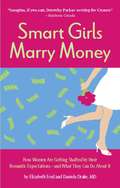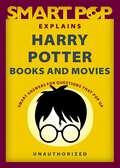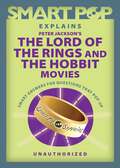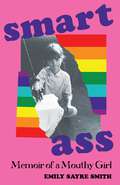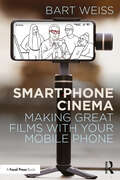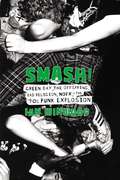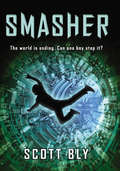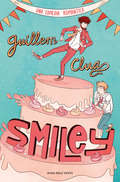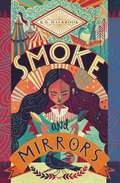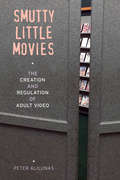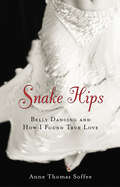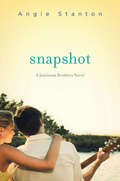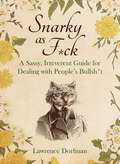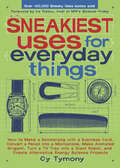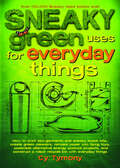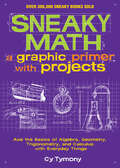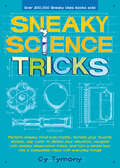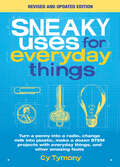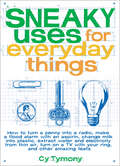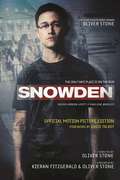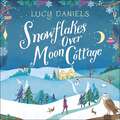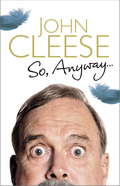- Table View
- List View
Smart Girls Marry Money: How Women Have Been Duped Into the Romantic Dream--And How They're Paying For It
by Ford Elizabeth Drake DanielaWhen did gold-digging become a four-letter word?
Smart Pop Explains Harry Potter Books and Movies
by The Editors of Smart PopWho is Snape? What&’s a horcrux? When did Sirius Black escape from Azkaban? Why was Hermione sorted into Gryffindor? It&’s easy for new fans to get overwhelmed by the sprawling mythology and complexity of the Harry Potter movies and books. Unlike encyclopedias and guides that offer diehard fans trivia, details, and deep dives into every on-screen moment, this first-of-its-kind explainer is an easy, fun, and accessible introduction to the hundreds of characters, plots, and interconnected stories that make up one of the greatest pop culture franchises of all time. Maybe you&’re a First Year and need an entry level class on the magical Hogwarts School of Witchcraft and Wizardry? Are you trying to figure out why Slytherins are so slippery? Trying to parcel out parceltongue? Having trouble sorting out when Dumbledore battled Grindelwald? Or maybe you&’re a confident Ravenclaw who wants to understand why it&’s leviOsa, not levioSA! If you&’re a Muggle, witch, or wizard looking for an easy entry into what literally everyone is talking about then this is the book for you. As the perfect and unauthorized resource to keep on hand when watching something for the first—or tenth—time, Smart Pop ExplainsHarry Potter Movies and Books to you like no one could!
Smart Pop Explains Marvel Movies and TV Shows
by The Editors of Smart PopWho is Iron Man? What&’s an Infinity Stone? When did Captain America become the first Avenger? Why does everyone love Loki even though he&’s a bad guy? It&’s easy for new fans to get overwhelmed by the sprawling mythology and complexity of the Marvel Cinematic Universe, which now spans more than 20 films and TV shows. Unlike encyclopedias and guides that offer diehard fans trivia, details, and deep dives into every on-screen moment, this first-of-its-kind explainer is an easy, fun, and accessible introduction to the hundreds of characters, plots, and interconnected stories that make up one of the greatest pop-culture franchises of all time. Do you want to enjoy Spider-Man, but don&’t quite know what a Skrull is? Maybe you know that it was Agatha all along, but did maybe WandaVision leave you wondering about the multiverse of madness? Do you need a primer on Thor&’s backstory so you can grasp how The God of Thunder became friends with The Guardians of the Galaxy? Or, maybe you just want to be able to join in when everyone shouts out &“Wakanda Forever!&” If you&’re looking for an easy to access entry into what literally everyone is talking about, this is the book for you! As the perfect and unauthorized resource to keep on hand when watching something for the first—or tenth—time, Smart Pop Explains Marvel Movies and TV Shows like no one else could.
Smart Pop Explains Peter Jackson's The Lord of the Rings and The Hobbit Movies
by Peter Jackson’sReturn to Middle-earth ahead of Amazon Prime's new series The Lord of the Rings: The Rings of Power If you&’re feeling lost on the way to Mordor, let Smart Pop be your guide—literally, with this handy crash course into the cinematic world of Hobbits and Orcs and Elves (oh my!) It&’s easy for new fans to get overwhelmed by the sprawling mythology and complexity of the six films that make up Peter Jackson&’s epic trilogies. Unlike encyclopedias and guides that offer diehard J.R.R. Tolkien fans trivia, details, and deep dives into every on-screen moment, this first-of-its kind explainer is an easy, fun, and accessible introduction to the characters, plots, and interconnected stories that make up one of the greatest pop culture franchises of all time. Smart Pop has all of your burning questions covered: Who is Frodo? Why are there so many rings? When did Gandalf the Grey have time to change outfits and become Gandalf the White? Why does everyone love Gollum even though he&’s a bad guy? And more! As the perfect and unauthorized resource to keep on hand when rewatching the films for the first—or tenth time, or as a primer for the upcoming live action series, Smart Pop Explains Peter Jackson&’s The Lord of the Rings and The Hobbit Movies to you like no one could!
Smartass: Memoir of a Mouthy Girl
by Emily Sayre SmithPerfect for anyone interested in the behind-the-scenes of the ballet world, a rousing memoir of a brash young ballerina from a dysfunctional family who achieves her greatest dream only to realize—as she begins to find success—that she&’s gay.With a priest for a father and a magician for a mother, Emily Sayre Smith was always going to have an interesting life—for better and for worse. Here, she recounts what it was like coming of age in Texas and Arizona in the &’50s, &’60s, and &’70s in a decidedly dysfunctional family. To escape her turbulent family life, Emily throws herself into her ballet classes, where she can dance out the anxiety in her body and take refuge in fantasy worlds. Driven by the dream of being a ballerina, she earns scholarships and lead roles, studies in London for two years, and eventually lands back in Tucson, where she joins a fledgling ballet company and falls in love—with a woman and with marijuana. Join Emily as she survives her troubled family, hangs out with dance royalty, saves Martha Graham, meets the Queen of England, slings hash in a diner, discovers her sexuality, and tries to figure out how it&’s all going fit together in her ballerina world in this story of a brave and sometimes bumbling girl charging her way through life.
Smartphone Cinema: Making Great Films with Your Mobile Phone
by Bart WeissThis book guides you through the process of using your phone to create different kinds of video and audio for TV, theaters, YouTube, TikTok, and podcasts.Drawing from the author’s experience teaching classes on mobile filmmaking, this resource helps you tell stories better whilst going over the techniques necessary to control the phone professionally, also covering the accessories and software that can help you shape your narrative. Within the chapters you will first learn how to tell a compelling story, before delving into the proper methods for shooting video on your phone effectively and recording high quality audio. The book then explains the best techniques for editing and mixing these components together, always with the smartphone format in mind. Chapters also include the expert knowledge of a wide array of media makers that utilize this medium, from filmmakers to influencers, who give insight into the specific tools they use and how they approach the mobile phone as the hub of their creativity.This book will be a guide to first time makers, students of many disciplines (including student filmmakers), and professional filmmakers who want to leverage what the phone can bring to a shoot.
Smash!: Green Day, The Offspring, Bad Religion, NOFX, and the '90s Punk Explosion
by Ian WinwoodA group biography of '90s punk rock told through the prism of Green Day, The Offspring, NOFX, Rancid, Bad Religion, Social Distortion, and moreTwo decades after the Sex Pistols and the Ramones birthed punk music into the world, their artistic heirs burst onto the scene and changed the genre forever. While the punk originators remained underground favorites and were slow burns commercially, their heirs shattered commercial expectations for the genre. In 1994, Green Day and The Offspring each released their third albums, and the results were astounding. Green Day's Dookie went on to sell more than 15 million copies and The Offspring's Smash remains the all-time bestselling album released on an independent label. The times had changed, and so had the music.While many books, articles, and documentaries focus on the rise of punk in the '70s, few spend any substantial time on its resurgence in the '90s. Smash! is the first to do so, detailing the circumstances surrounding the shift in '90s music culture away from grunge and legitimizing what many first-generation punks regard as post-punk, new wave, and generally anything but true punk music.With astounding access to all the key players of the time, including members of Green Day, The Offspring, NOFX, Rancid, Bad Religion, Social Distortion, and many others, renowned music writer Ian Winwood at last gives this significant, substantive, and compelling story its due. Punk rock bands were never truly successful or indeed truly famous, and that was that--until it wasn't. Smash! is the story of how the underdogs finally won and forever altered the landscape of mainstream music.
Smasher
by Scott BlyIn this riveting suspense thriller, two children race the clock to stop a futuristic murderer and his plan to enslave the world. In thirty days, a cold-hearted corporate tycoon will unleash a deadly biological computer virus on the entire world. As the public eagerly awaits his invention that promises ultimate relaxation, harmony, and community, the evil big-business sorcerer plans to put an end to freedom. Can he be stopped? The world's only hope is if Charlie, a math genius with otherworldly skills, and Geneva, a robotic girl from the future, can team up to track down some very dark secrets. With a method that uses atomic particles, Geneva and Charlie use "Smasher" to break through the walls of time. They travel to find an unlikely solution. But will it work? Fresh, unique, and gripping, this page-turner also celebrates the power of love, hope, and friendship as it also raises provocative questions about technology, progress, and the nature of persecution.
Smiley
by Guillem CluaSmiley és una història d'amor en lletres majúscules. Una llegenda japonesa diu que quan dues persones estan destinades a estar juntes, un fil vermell invisible lligat al dit petit de la mà esquerra les uneix des del dia del seu naixement. Aquest fil no es pot trencar, i pot lligar-les per sempre, encara que siguin molt lluny l'una de l'altra i malgrat que puguin ser molt diferents. Aquest sembla el cas de l'Àlex i el Bruno, els protagonistes de la comèdia romàntica que ha emocionat milers d'espectadors arreu del món. Segurament no es fixarien mai l'un en l'altre, però un equívoc farà que el que ha començat com una cita qualsevol els acabi canviant la vida per sempre. Smiley és una història d'amor en lletres majúscules. Fa riure i emociona. Mostra les pors a les quals ens enfrontem quan ens enamorem i les contradiccions de les relacions afectives dins de la comunitat gai, marcades per l'influx de les noves tecnologies i les aplicacions de cites online. I, a la vegada, és una petita viquipèdia de l'ambient barceloní i un homenatge a les comèdies romàntiques de tota la vida, de Nora Ephron a Howard Hawks. Smiley és tot això i molt més, però per sobre de tot, és un cant a l'amor en totes les seves formes. Guillem Clua va estrenar Smiley, una història d'amor el 2012 a la diminuta Sala Flyhard de Barcelona. Interpretada per Ramon Pujol (Àlex) i Albert Triola (Bruno) i amb direcció de l'autor, l'obra va estar en cartell a diferents teatres de la ciutat i en gira per Catalunya gairebé tres anys. La benedicció del públic (d'allò més divers: parelles heterosexuals, grups d'àvies, famílies senceres...) va venir acompanyada de crítiques entusiastes i tota mena de reconeixements. Va fer temporada a Madrid i des d'aleshores ha voltat per tot el món en diverses produccions internacionals, de Santiago de Xile a Atenes, de Miami a Berlín, de Nàpols a Nova York. Les últimes ciutats on s'ha pogut veure són Brisbane (Austràlia) i Singapur. Smiley s'ha convertit així en un fenomen global, capaç de traslladar al mainstream una comèdia romàntica protagonitzada per dos homes, amb final feliç i petó de pel·lícula. Les relacions de parella, però, evolucionen. Algunes milloren i altres s'acaben... o es converteixen en tota una altra cosa. Què va ser de l'Àlex i el Bruno després d'aquell happy ending? Van aconseguir superar les seves diferències i formar una parella estable? Van ser monògams o van iniciar una relació oberta? Feliços o infeliços? Smiley, després de l'amor, estrenada a l'Aquitània Teatre el 2020, respon a totes aquestes preguntes i moltes més, perquè han canviat moltes coses des d'aquella primera cita del 2012. Barcelona ja no és la mateixa ciutat, i l'Àlex i el Bruno... tampoc: ara els preocupen la crisi dels quaranta, el matrimoni, el final de la joventut i la pèrdua de la innocència. Aquesta edició reuneix elstextos de Smiley, una història d'amor i Smiley, després de l'amor. I qui ho sap, potser l'any 2030 ens tornem a trobar amb l'Àlex i el Bruno amb una tercera part que molts espectadors i lectors ja esperen amb impaciència.
Smoke and Mirrors
by K. D. Halbrook“The novel’s wistful prose and a relatable search for the Light will be rewarding for readers who can see in the Smoke any number of metaphors for the things that haunt us.” —BCCB (starred review) “A Wrinkle in Time-inspired adventure…Halbrook’s writing is artful.” —Kirkus Reviews “In K.D. Halbrook’s gorgeous prose, readers will be drawn immediately into the Cirque, but more importantly, they’ll be drawn into Sasha’s heart. This is a story to savor.” —Kathi Appelt, National Book Award finalist and Newbery Honor–winning author of The Underneath and Keeper “Adventure and magic unfold in this captivating story.” —School Library Connection “A fairy-tale atmosphere wafts through Halbrook’s story of magic, love, belonging, and circus...Enchanting.” —Booklist Circus Mirandus meets Cartwheeling in Thunderstorms in this beautifully written fantasy novel about a girl who must face her fears in order to right a terrible wrong, confront what it means to be different, and discover her own power.Smoke has come to the Cirque Magnifique. And Sasha Brown is sure it is her fault. Sasha has always loved the Cirque, a place filled with sequined costumes, dazzling spotlights, and magnificent tents. But when she starts fifth grade with the Islanders—the ordinary folk from the other side of the Island—for the first time, she’s not so sure she wants to be a Cirque kid. She starts to question her home and her Cirque family. Is the magic real? Are the stories even true? As the bullying by the Island kids gets worse, swirling blue-gray Smoke appears. One night in the big tent, Sasha’s dad performs, twisting his body through the air as the lights dance. Sasha is supposed to be helping, but instead she sits beneath the bleachers, seething. She has wished for the Smoke to come and make it all disappear: the Cirque, her family, the Island with its mean Island kids. And the Smoke does come. As Sasha watches her dad, he flips and raises his arms out for the bar that is supposed to meet him, his bright grin confident and sure. But there is only air…and Smoke. Both of Sasha’s parents disappear that night, and it’s all Sasha’s fault. What can she do but try and find them?
Smutty Little Movies: The Creation and Regulation of Adult Video
by Peter AlilunasIn the late 1970s, the adult film industry began the transition from celluloid to home video. Smutty Little Movies traces this change and examines the cultural and legal efforts to regulate, contain, limit, or eradicate pornography. Drawing on a wide variety of materials, Smutty Little Movies de-centers the film text in favor of industry histories and contexts. In so doing, the book argues that the struggles to contain and regulate pleasure represent a primary starting point for situating adult video's place in a larger history, not just of pornography, but of media history as a whole.
Snake Hips: Belly Dancing and How I Found True Love
by Anne Thomas SoffeeThis hilariously uplifting memoir follows an Arab American woman's merry life as she shimmies her way from getting dumped by her tattoo-artist boyfriend to coming to grips with being single, ample, and 30. Feeling lost and heartbroken, Anne Thomas Soffee moves back home to Richmond, Virginia. Against the wishes of her extended family and friends, she enrolls in a belly dancing class hoping to heal her heart and reconnect with her Lebanese roots. Her life is never the same after she discovers the riotous world of American belly dancing, a warm and welcoming subculture where younger and thinner are not necessarily better. Wildly funny adventures ensue as a newly confident Soffee embarks on romantic adventures with a domineering sheik and a beautiful Lebanese boy-next-door. Among the zils (finger cymbals) and thrills of attending classes and performing in moose lodges and county fairs, Soffee is surprised to find happiness and true love along the way. This replaces 1556524587.
Snapshot: A Jamieson Brothers Novel
by Angie StantonOne kiss will change Marti's summer . . . forever. Marti Marti just wants a normal life. After dealing with her irresponsible rock-legend father and absentee mother, she only wants some peace . . . and fun. And that includes a summer at an exclusive arts camp. Adam For Adam, a normal life is not possible—not when he is the lead guitarist in a rock band with his brothers. So he's thrilled to finally have an opportunity to disguise himself and live like a normal teenager at summer camp. And when Adam meets Marti, sparks fly. Between romantic bonfires and stolen kisses, they are inseparable. Then Marti discovers who Adam truly is, and her world is turned upside down. Ever since her father nearly ruined her life, she vowed never to fall for a rocker. But when tragedy strikes, Marti is forced to look within. And she discovers that maybe falling in love with a rock star is not so crazy after all.
Snarky As F*ck: A Sassy, Irreverant Guide for Dealing with People's Bullsh*t
by Lawrence DorfmanLearn how to become the most glorious a**shole the world has ever seen. Are you tired of everyone&’s bullsh*t? Responding to their dumba** questions? Making boring small talk and offering robotic replies? Can&’t take one more monotonous, people-pleasing conversation with a distant family member or a friend&’s friend? If you have no f*cks left to give and want to dish out some serious snark, grab a copy Snarky as F*ck, the premiere guide to all things sarcastic and sardonic. Explore topics such as: Sex and Romance (Responses to D*ck Pics, Mansplaining, and More) Geography (Snarkiest States in the US!) 21st Century Snark (Curse Word Definitions, Inspirational Bullsh*t, etc.) In the Workplace (Snarky Replies, Sotto Voce Things to Say to Your Boss) Family, Friends, and other Influencers (Greeting Cards for Bastards, and Insults for Around the Dinner Table!) Movies, Television, and Music (&“I&’m clapping because it&’s finished, not because I like it.&”) Politics and Government (Presidential Insults and Your New Favorite Game: Match the Scandal!) In the News (Florida Man, Karen and Brad, Idiots on Wheels, et al) Hear wit, sarcasm, and offhanded comments from masters like Dorothy Parker, Groucho Marx, H. L. Mencken, Oscar Wilde, Robert Benchley, George Bernard Shaw, Jules Feiffer, Bill Hicks, Bill Maher, Phyllis Diller, Édith Piaf, W. C. Fields, Mark Twain, Voltaire, Charles Bukowski, to name a few. This lofty tome promises to fulfill the need to chuckle, guffaw, titter, groan, and belly laugh as readers dip in and out of the great minds in literature, comedy, movies, music, and more. Proceed with caution, but know you&’ll come out the other side one snarky motherf*cker, ready to take on the world, one idiot at a time.
Sneakier Uses for Everyday Things: Power Devices With Your Plants, Modify High-tech Toys, Turn A Penny Into A Battery, And More (Sneaky Books #2)
by Cy TymonyThe author of Sneaky Uses for Everyday Things is back with an all-new compendium of creative inventions you can make at home. Did you know that your standard issue of Sports Illustrated can be turned into more than twenty useful gadgets? In Sneakier Uses for Everyday Things, Cy Tymony reveals how an ordinary magazine can become many extraordinary gadgets such as a compass, hearing aid, magnifier, peashooter, and bottle opener. Sneakier Uses for Everyday Things covers forty educational and unique projects that anybody can successfully complete with simple household items. The book includes a list of necessary materials, detailed sketches, and step-by-step instructions for each gadget and gizmo. Among the sneaky schemes are: * Creating a electroscope out of a glass jar * Turning a drinking cup into a speaker * Using an AM radio as a metal detector * Making a spy gadget jacket with over twenty individual sneaky uses ranging from a siren and whistle to a walkie-talkie and voice recorder
Sneakiest Uses for Everyday Things: How to Make a Boomerang with a Business Card, Convert a Pencil into a Microphone, Make Animated Origami, Turn a TV Tray into a Giant Robot, and Create Alternative Energy Science Projects (Sneaky Books #3)
by Cy TymonyThe third volume in the Sneaky Uses series features fifty all-new amazing projects made from ordinary household items. Master of homemade inventions Cy Tymony is back with the absolute Sneakiest Uses for Everyday Things! Would-be inventers, junk drawer aficionados, and science-fair parents rejoice as Cy helps you bring out your inner MacGyver. In these pages you will learn how to turn a piece of paper into a Frisbee, a business card into a boomerang, a TV tray into a robot, and more. Beginning with a complete list of materials and some sneaky science fun-damentals, Cy presents easy-to-follow step-by-step instructions paired with helpful illustrations. Most projects will be completed in just minutes using common items found around the house.
Sneaky Green Uses for Everyday Things: How to Craft Eco-Garments and Sneaky Snack Kits, Create Green Cleaners, Remake Paper Into Flying Toys, Assemble Alternative Energy Science Projects, and Construct a Robot Recycle Bin with Everyday Things (Sneaky Bks. #6)
by Cy TymonyThe author of the Sneaky Uses series shares creative ways to go green with forty projects that help you reuse, recycle, conserve energy—and have fun! In Sneaky Green Uses for Everyday Things, Cy Tymony combines his sneaky science known-how with Earth-friendly techniques to offer an all-new volume of easy, fun, and practical projects. With step-by-step instructions and illustrations, you&’ll learn how to conserve energy and reduce waste around the home while enjoying the fun of tinkering. With this volume, you can turn ordinary household items into: · A Solar Power Generator · A Robot Recycle Bin · A Sneaky Green Eco-Hat · Animated Origami · And much more! &“Thank you, Cy, for reinvigorating those creative juices [and] opening up the world of tinkering and creativity to a whole new generation of hobbyists looking to get their hands dirty with new and exciting projects." —Ira Flatow, host of NPR's Science Friday
Sneaky Math: A Graphic Primer with Projects (Sneaky Books #9)
by Cy Tymony&“By capitalizing on these real-world applications, Tymony helps conquer much of the fear and dread associated with traditional math lessons.&” (Booklist) Cy Tymony, author of the best-selling Sneaky Uses series, brings his unique, fun hands-on learning approach to all things math. Many people fear math and numbers, even Barbie, who famously said &“Math class is tough&” in her controversial 1992 talking doll version. But in Sneaky Math, Cy Tymony takes tough and turns it into triumph. He shows us how math is all around us through intriguing and easy projects, including twenty pass-along tools to complement math education programs. The book is divided into seven sections: 1. Fundamentals of Numbers and Arithmetic 2. Algebra Primer 3. Geometry Primer 4. Trigonometry Primer 5. Calculus Primer 6. Sneaky Math Challenges, Tricks, and Formulas 7. Resources
Sneaky Math: A Graphic Primer with Projects (Sneaky Books)
by Cy Tymony&“By capitalizing on these real-world applications, Tymony helps conquer much of the fear and dread associated with traditional math lessons.&” (Booklist) Cy Tymony, author of the best-selling Sneaky Uses series, brings his unique, fun hands-on learning approach to all things math. Many people fear math and numbers, even Barbie, who famously said &“Math class is tough&” in her controversial 1992 talking doll version. But in Sneaky Math, Cy Tymony takes tough and turns it into triumph. He shows us how math is all around us through intriguing and easy projects, including twenty pass-along tools to complement math education programs. The book is divided into seven sections: 1. Fundamentals of Numbers and Arithmetic 2. Algebra Primer 3. Geometry Primer 4. Trigonometry Primer 5. Calculus Primer 6. Sneaky Math Challenges, Tricks, and Formulas 7. Resources
Sneaky Science Tricks: Perform Sneaky Mind-Over-Matter, Levitate Your Favorite Photos, Use Water to Detect Your Elevation, Navigate with Sneaky Observation Tricks, and Turn a Cereal Box into A Collapsible Robot with Everyday Things (Sneaky Books #7)
by Cy TymonyThe author of the Sneaky Uses series shares a uniquely entertaining and educational how-to guide for the sly and curious among us. Author, inventor, and delightfully mad scientist Cy Tymony combines the fun of his Sneaky Uses series with a host of fascinating science facts and resourceful tricks. With step-by-step instructions and illustrations, you&’ll learn how to turn ordinary household items into a helicopter, a hand-powered fan, a clever moon direction trick, and much more! Tymony also includes tons of sneaky trivia on plants and animals, geography, and physics, making Sneaky Science Tricks an ideal guidebook for sneaky scientists of all ages.
Sneaky Uses for Everyday Things, Revised Edition: Turn a Penny into a Radio, Change Milk into Plastic, Make a Dozen STEM projects with Everyday Things, and Other Amazing Feats (Sneaky Books)
by Cy Tymony&“A science activity book &“offering readers a chance to become real-life MacGyvers... [with] sections on gimmicks, gadgets and survival techniques. . . .&” (Publishers Weekly) Do you know how to make something that can tell whether the $20 bill in your wallet is a fake? Or how to generate battery power with simple household items? Or how to create your own home security system? Science-savvy author Cy Tymony does. And now you can learn how to create these things and more than forty other handy gadgets and gizmos in Sneaky Uses for Everyday Things. More than a simple do-it-yourself guide, this quirky collection is a valuable resource for transforming ordinary objects into the extraordinary. With over 80 solutions and bonus applications at your disposal, you will be ready for almost any situation. Included are survival, security, self-defense, and silly applications that are just plain fun. You'll be seen as a superhero as you amaze your friends by: * Transforming a simple FM radio into a device that enables you to eavesdrop on tower-to-air conversations. * Creating your own personalized electronic greeting cards. * Making a compact fire extinguisher from items typically found in a kitchen pantry. * Thwarting intruders with a single rubber band. By using run-of-the-mill household items and the easy-to-follow instructions and diagrams within, you'll be able to complete most projects in just a few minutes. Whether you use Sneaky Uses for Everyday Things as a practical tool to build useful devices, a fun little fantasy escape, or as a trivia guide to impress friends and family, this book is sure to be a reference favorite for years to come.
Sneaky Uses for Everyday Things: How to Turn a Penny into a Radio, Make a Flood Alarm with an Aspirin, Change Milk into Plastic, Extract Water and Electricity from Thin Air, Turn on a TV with your Ring, and Other Amazing Feats (Sneaky Books #1)
by Cy TymonyThe original, practical guide that offers readers &“a chance to become real-life MacGyvers&” with &“sections on gimmicks, gadgets and survival techniques&” (Publishers Weekly). Do you know how to generate battery power with simple household items? Or how to create your own home security system? Science-savvy author Cy Tymony does. And now you can learn how to create these things—and more than 40 other handy gadgets and gizmos—in Sneaky Uses For Everyday Things. More than a simple do-it-yourself guide, this quirky collection teaches you how to transform ordinary objects into the extraordinary just a few minutes. With more than 80 solutions and bonus applications at your disposal, you will be ready for almost any situation. Included are survival, security, self-defense, and silly applications that are just plain fun
Snowden: Official Motion Picture Edition
by David Talbot Oliver Stone Kieran FitzgeraldFrom director and screenwriter Oliver Stone, Snowden examines the life and actions of one of the most polarizing figures in modern history. In 2013, Edward Snowden quietly leaves his job at the NSA and flies to Hong Kong to meet with journalists Glenn Greenwald and Ewen MacAskill, as well as filmmaker Laura Poitras, to expose the US government’s secret—and shockingly extensive—cyber surveillance programs. A top security contractor with virtuoso programming skills, Snowden’s monumental act has been called heroic, treasonous, and the most far-reaching security breach in US intelligence history. This official motion picture screenplay edition, written by Kieran Fitzgerald and Oliver Stone, includes a foreword by David Talbot and dozens of photos from the film that features Zachary Quinto, Tom Wilkinson, Melissa Leo, and Joseph Gordon-Levitt as Snowden.
Snowflakes over Moon Cottage: Hope Meadows, Book 4 (Animal Ark Revisited #4)
by Lucy DanielsThe fourth novel in the heartwarming, countryside-set Hope Meadows series.It's Christmas-time in the little Yorkshire village of Welford, and the first snowflakes are just starting to fall. As far as Susan Collins is concerned, this Christmas is all about quality time with her family, especially her son Jack. After a string of terrible dates she's given up on love, and Susan's certainly got plenty to keep her busy. That is, until she meets handsome children's author Douglas Macleod. Dishevelled in appearance with bright red hair he is the opposite of Susan's usual type, but an undeniable spark soon lights up between them. But then Michael Chalk, Jack's father, turns up on the scene wanting to be a family again - and Susan finds herself torn. With snow settling on the ground and the big day fast approaching, who will Susan and Jack be choosing to spend Christmas at Moon Cottage with this year? Hope Meadows is based on the globally bestselling Animal Ark series. Perfect for fans of Katie Fforde, Heidi Swain and Cathy Bramley.*****Praise for the Hope Meadows series**'A stunning, emotional, beautiful tale of friendship and love' Books of All Kinds'Just the right amount of nostalgia... wonderful and very poignant' - The World is a Book Blog'Will leave you feeling cosy and uplifted' - Goodreads'An adorable read [with] a real sense of village community' Bookworms and Shutterbugs(P)2019 Hodder & Stoughton Limited
So Anyway
by John CleeseJohn Cleese's huge comedic influence has stretched across generations; his sharp irreverent eye and the unique brand of physical comedy he perfected with Monty Python, on Fawlty Towers, and beyond now seem written into comedy's DNA. In this rollicking memoir, So, Anyway..., Cleese takes readers on a Grand Tour of his ascent in the entertainment world, from his humble beginnings in a sleepy English town and his early comedic days at Cambridge University (with future Python partner Graham Chapman), to the founding of the landmark comedy troupe that would propel him to worldwide renown.Cleese was just days away from graduating Cambridge and setting off on a law career when he was visited by two BBC executives, who offered him a job writing comedy for radio. That fateful moment--and a near-simultaneous offer to take his university humour revue to London's famed West End--propelled him down a different path, cutting his teeth writing for stars like David Frost and Peter Sellers, and eventually joining the five other Pythons to pioneer a new kind of comedy that prized invention, silliness, and absurdity. Along the way, he found his first true love with the actress Connie Booth and transformed himself from a reluctant performer to a world-class actor and back again.Twisting and turning through surprising stories and hilarious digressions--with some brief pauses along the way that comprise a fascinating primer on what's funny and why--this story of a young man's journey to the pinnacle of comedy is a masterly performance by a master performer.
